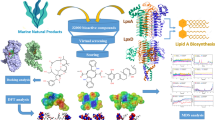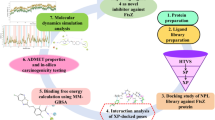Abstract
Reaction of 6-alkoxy-2-oxo-2H-chromen-4-carbaldehydes with N-(2,3,4,6-tetra-O-acetyl-β-d-glucopyranosyl)thiosemicarbazide yielded corresponding thiosemicarbazones having 2H-chromen-2-one ring. In vitro evaluations showed that these 2H-chromen-2-one compounds exhibited remarkable antibacterial and antifungal activities against some typical bacteria and fungi. Representative compounds with MIC values of 0.78 − 1.56 μg/mL were 6c, 6g (against S. aureus), 6a, 6f (against S. epidermidis) (Gram-positive bacterial strains), 6e, 6g (against E. coli), 6b, 6e (against K. pneumoniae), and 6d–f (against S. typhimurium) (Gram-negative bacterial strains). Almost all thiosemicarbazones 6a–g had no activity against Gram-positive bacterial strain B. subtilis at these MIC values. Some compounds had strong inhibitory activity against several bacteria, such as 6b (for K. pneumoniae and S. typhimurium), 6d, 6e (for E. coli, K. pneumoniae, and S. typhimurium), 6f (for S. aureus, E. coli, and S. typhimurium), and 6g (for B. subtilis, S. aureus, E. coli, and K. pneumoniae). Some compounds had remarkable inhibitory activity against three clinical MRSA isolates with MIC values of 0.78–6.25 μg/mL. Docking study showed that compound 6g is compatible with the active site of S. aureus DNA gyrase 2XCT, which suggested that the tested compounds inhibited the synthesis of this enzyme.







Similar content being viewed by others
References
Martins Alho MA, D’Accorso NB. Behavior of free sugar thiosemicarbazones toward heterocyclization reactions. Carbohydr Res. 2000;328:481–88. https://doi.org/10.1016/S0008-6215(00)00127-0.
de Aquino TM, Liesen AP, da Silva REA, Lima VT, Carvalho CS, de Faria AR, et al. Synthesis, anti-Toxoplasma gondii and antimicrobial activities of benzaldehyde 4-phenyl-3-thiosemicarbazones and 2-[(phenylmethylene)hydrazono]-4-oxo-3-phenyl-5-thiazolidineacetic acids. Bioorg Med Chem. 2008;16:446–56. https://doi.org/10.1016/j.bmc.2007.09.025.
Ghosh S, Misra AK, Bhatia G, Khan MM, Khanna AK. Syntheses and evaluation of glucosyl aryl thiosemicarbazide and glucosyl thiosemicarbazone derivatives as antioxidant and anti-dyslipidemic agents. Bioorg Med Chem Lett. 2009;19:386–89. https://doi.org/10.1016/j.bmcl.2008.11.070.
Tenchiu A-C, Kostas ID, Kovala-Demertzi D, Terzis A. Synthesis and characterization of new aromatic aldehyde/ketone 4-(β-d-glucopyranosyl)thiosemicarbazones. Carbohydr Res. 2009;344:1352–64. https://doi.org/10.1016/j.carres.2009.05.010.
Mosa AI, Ibrahim MM, Aldhlmani SA. Spectroscopic and solution studies of some transition metal complexes of new 4-hydroxy coumarin semi- and thiosemicarbazone complexes. J Solut Chem. 2013;42:2364–83. https://doi.org/10.1007/s10953-013-0108-5.
Bal-Demirci T, Şahin M, Kondakçı E, Özyürek M, Ülküseven B, Apak R. Synthesis and antioxidant activities of transition metal complexes based 3-hydroxysalicylaldehyde-S-methylthiosemicarbazone. Spectrochim Acta A: Mol Biomol Spectr. 2015;138:866–72. https://doi.org/10.1016/j.saa.2014.10.088.
Maddireddy M, Kulkarni AD, Bagihalli GB, Malladi S. Thiosemicarbazone scaffold as a multidentate ligand for transition-metal ions: synthesis, characterization, in vitro antimicrobial, anthelmintic, DNA cleavage, and cytotoxic studies. Helv Chim Acta. 2016;99:562–72. https://doi.org/10.1002/hlca.201600045.
Rogolino D, Gatti A, Carcelli M, Pelosi G, Bisceglie F, Restivo FM, et al. Thiosemicarbazone scaffold for the design of antifungal and antiaflatoxigenic agents: evaluation of ligands and related copper complexes. Sci Rep. 2017;7:11214. https://doi.org/10.1038/s41598-017-11716-w.
Kenny RS, Mashelkar UC. Synthesis of 2-aryl and coumarin substituted benzothiazole derivatives. J Heterocycl Chem. 2006;43:1367–69. https://doi.org/10.1002/jhet.5570430535.
Kumbar SS, Hosamani KM, Gouripur GC, Joshi SD. Functionalization of 3-chloroformylcoumarin to coumarin Schiff bases using reusable catalyst: an approach to molecular docking and biological studies. R Soc Open Sci. 2018;5:172416–16. https://doi.org/10.1098/rsos.172416.
Rene L, Lefebvre A, Auzou G. An easy conversion of 2H-chromenes into coumarins: an entry to 3-formyl coumarins. Synthesis. 1986:567–69. https://doi.org/10.1055/s-1986-31707.
Lim NC, Schuster JV, Porto MC, Tanudra MA, Yao L, Freake HC, et al. Coumarin-based chemosensors for zinc (II): toward the determination of the design algorithm for CHEF-type and ratiometric probes. Inorg Chem. 2005;44:2018–30. https://doi.org/10.1021/ic048905r.
Mosettig E, Mozingo R. The Rosenmund Reduction of Acid Chlorides to Aldehydes. In: Adams R, editor. Organic Reactions. New Jersey (USA): John Wiley and Sons, Inc.; 1948. pp. 362–77.
Olomola TO, Klein R, Kaye PT. Convenient synthesis of 3-methylcoumarins and Coumarin-3-carbaldehydes. Synth Commun. 2012;42:251–57. https://doi.org/10.1080/00397911.2010.523491.
Hou J-T, Li K, Liu B-Y, Liao Y-X, Yu X-Q. The first ratiometric probe for lysine in water. Tetrahedron. 2013;69:2118–23. https://doi.org/10.1016/j.tet.2013.01.010.
Bochkov AY, Akchurin IO, Traven VF. A new facile way for the preparation of 3-formylcoumarins. Heterocycl Commun. 2017;23:75–8. https://doi.org/10.1515/hc-2017-0038.
Matos MJ, Santana L, Uriarte E, Abreu OA, Molina E, Yordi EG. Coumarins—an important class of phytochemicals. In: Rao AV, Rao LG, editors. Phytochemicals—isolation, characterisation and role in human health. London, UK: IntechOpen; 2015. pp. 113–40.
Venugopala KN, Rashmi V, Odhav B. Review on natural coumarin lead compounds for their pharmacological activity. BioMed Res Int. 2013;2013:963248. https://doi.org/10.1155/2013/963248.
de Souza SM, Monache FD, Smânia A. Antibacterial activity of coumarins. Z Naturforsch C: Biosci. 2005;60:693. https://doi.org/10.1515/znc-2005-9-1006.
Guilherme Borges B, Damiana da Rocha V, Alexander M-R, Gilsane von P, Rosa Maria L-R, Vera Lucia E-L, et al. The antioxidant activity of coumarins and flavonoids. Mini-Rev Med Chem. 2013;13:318–34. https://doi.org/10.2174/1389557511313030002.
Bansal Y, Sethi P, Bansal G. Coumarin: a potential nucleus for anti-inflammatory molecules. Med Chem Res. 2013;22:3049–60. https://doi.org/10.1007/s00044-012-0321-6.
Yang F, Zhao N, Song J, Zhu K, Jiang C-s, Shan P, et al. Design, synthesis and biological evaluation of novel coumarin-based hydroxamate derivatives as histone deacetylase (Hdac) inhibitors with antitumor activities. Molecules. 2019;24:2569. https://doi.org/10.3390/molecules24142569.
Prusty JS, Kumar A. Coumarins: antifungal effectiveness and future therapeutic scope. Mol Divers. 2019. https://doi.org/10.1007/s11030-019-09992-x.
Detsi A, Kontogiorgis C, Hadjipavlou-Litina D. Coumarin derivatives: an updated patent review (2015–2016). Expert Opin Ther Pat. 2017;27:1201–26. https://doi.org/10.1080/13543776.2017.1360284.
Melita L, Gašo-Sokač D, Jokić S, Molnar M. Recent advances in the synthesis of coumarin derivatives from different starting materials. Biomolecules. 2020;10:151. https://doi.org/10.3390/biom10010151.
Yang J, Liu G-Y, Dai F, Cao X-Y, Kang Y-f, Hu L-M, et al. Synthesis and biological evaluation of hydroxylated 3-phenylcoumarins as antioxidants and antiproliferative agents. Bioorg Med Chem Lett. 2011;21:6420–25. https://doi.org/10.1016/j.bmcl.2011.08.090.
Pérez-Cruz F, Vazquez-Rodriguez S, Matos MJ, Herrera-Morales A, Villamena FA, Das A, et al. Synthesis and electrochemical and biological studies of novel coumarin–chalcone hybrid compounds. J Med Chem. 2013;56:6136–45. https://doi.org/10.1021/jm400546y.
Serra S, Ferino G, Matos MJ, Vázquez-Rodríguez S, Delogu G, Viña D, et al. Hydroxycoumarins as selective MAO-B inhibitors. Bioorg Med Chem Lett. 2012;22:258–61. https://doi.org/10.1016/j.bmcl.2011.11.020.
Guerra F, Mazur M, Corridore D, Pasqualotto D, Nardi GM, Ottolenghi L. Evaluation of the esthetic properties of developmental defects of Enamel: a spectrophotometric clinical study. Sci World J 2015;2015:878235. https://doi.org/10.1155/2015/878235.
Guerra FQS, Araújo RSA, Sousa JP, Silva VA, Pereira FO, Mendonça-Junior FJB, et al. A new coumarin derivative, 4-acetatecoumarin, with antifungal activity and association study against Aspergillus spp. Braz J Microbiol. 2018;49:407–13. https://doi.org/10.1016/j.bjm.2017.06.009.
Ayine-Tora DM, Kingsford-Adaboh R, Asomaning WA, Harrison JJEK, Mills-Robertson FC, Bukari Y, et al. Coumarin antifungal lead compounds from Millettia thonningii and their predicted mechanism of action. Molecules. 2016;21:1369. https://doi.org/10.3390/molecules21101369.
Pisano MB, Kumar A, Medda R, Gatto G, Pal R, Fais A, et al. Antibacterial activity and molecular docking studies of a selected series of hydroxy-3-arylcoumarins. Molecules. 2019;24:2815. https://doi.org/10.3390/molecules24152815.
Maxwell A. The interaction between coumarin drugs and DNA gyrase. Mol Microbiol. 1993;9:681–86. https://doi.org/10.1111/j.1365-2958.1993.tb01728.x.
Kayser O, Kolodziej H. Antibacterial activity of simple coumarins: structural requirements for biological activity. Z Naturforsch C: Biosci. 1999;54:169–74. https://doi.org/10.1515/znc-1999-3-405.
Sardari S, Mori Y, Horita K, Micetich RG, Nishibe S, Daneshtalab M. Synthesis and antifungal activity of coumarins and angular furanocoumarins. Bioorg Med Chem. 1999;7:1933–40. https://doi.org/10.1016/S0968-0896(99)00138-8.
Penta S. Chapter 2—antimicrobial agents. In: Penta S, editor. Advances in structure and activity relationship of coumarin derivatives. Boston: Academic Press; 2016. pp. 9–45.
Thanh ND, Giang NTK, Quyen TH, Huong DT, Toan VN. Synthesis and evaluation of in vivo antioxidant, in vitro antibacterial, MRSA and antifungal activity of novel substituted isatin N-(2,3,4,6-tetra-O-acetyl-β-D-glucopyranosyl)thiosemicarbazones. Eur J Med Chem. 2016;123:532–43. https://doi.org/10.1016/j.ejmech.2016.07.074.
Bonaccorso C, Grasso G, Musso N, Barresi V, Condorelli DF, La Mendola D, et al. Water soluble glucose derivative of thiocarbohydrazone acts as ionophore with cytotoxic effects on tumor cells. J Inorg Biochem. 2018;182:92–102. https://doi.org/10.1016/j.jinorgbio.2018.01.019.
Fonseca NC, da Cruz LF, da Silva Villela F, do Nascimento Pereira GA, de Siqueira-Neto JL, Kellar D, et al. Synthesis of a sugar-based thiosemicarbazone series and structure-activity relationship versus the parasite cysteine proteases rhodesain, cruzain, and schistosoma mansoni cathepsin B1. Antimicrob Agents Chemother. 2015;59:2666–77. https://doi.org/10.1128/aac.04601-14.
Ito K, Maruyama J. Studies on stable diazoalkanes as potential fluorogenic reagents. I. 7-Substituted 4-diazomethylcoumarins. Chem Pharm Bull. 1983;31:3014–23. https://doi.org/10.1248/cpb.31.3014.
Hyodo K, Togashi K, Oishi N, Hasegawa G, Uchida K. Brønsted acid catalyzed transoximation reaction: synthesis of aldoximes and ketoximes without use of hydroxylamine salts. Green Chem. 2016;18:5788–93. https://doi.org/10.1039/C6GC02156E.
Thanh ND, Hai DS, Ngoc Bich VT, Thu Hien PT, Ky Duyen NT, Mai NT, et al. Efficient click chemistry towards novel 1H-1,2,3-triazole-tethered 4H-chromene−D-glucose conjugates: design, synthesis and evaluation of in vitro antibacterial, MRSA and antifungal activities. Eur J Med Chem. 2019;167:454–71. https://doi.org/10.1016/j.ejmech.2019.01.060.
Bax BD, Chan PF, Eggleston DS, Fosberry A, Gentry DR, Gorrec F, et al. Type IIA topoisomerase inhibition by a new class of antibacterial agents. Nature. 2010;466:935–40. https://doi.org/10.1038/nature09197.
Russell A, Frye JR. 2,6-Dihydroxyacetophenone. Org Synth. 1941;21:22. https://doi.org/10.15227/orgsyn.021.0022.
Lemieux RU. Tetra-O-acetyl-α-D-glucopyranosyl bromide. In: Wolfrom ML, BeMiller JN, editors. Methods in carbohydrate chemistry. New York, London: Academic Press; 1963. pp. 221–22.
Celikezen FC, Orek C, Parlak AE, Sarac K, Turkez H, Tozlu ÖÖ. Synthesis, structure, cytotoxic and antioxidant properties of 6-ethoxy-4-methylcoumarin. J Mol Struct. 2020;1205:127577. https://doi.org/10.1016/j.molstruc.2019.127577.
Jorgensen JH, Pfaller MA, Carroll KC, Funke G, Landry ML, Richter SS et al. Manual of Clinical Microbiology, Eleventh Edition. Washington, DC (USA): American Society of Microbiology Press; 2015. pp. 678–79.
Pignatello R, Spampinato G, Sorrenti V, Vicari L, di Giacomo C, Vanella A, et al. Aliphatic α,γ-bis(Amides) of Methotrexate. Influence of chain length on in vitro activity against sensitive and resistant tumour cells. Pharm Pharm Commun. 1999;5:299–305. https://doi.org/10.1211/146080899128734785.
Maxwell A, Burton NP, O’Hagan N. High-throughput assays for DNA gyrase and other topoisomerases. Nucleic Acids Res. 2006;34:e104. https://doi.org/10.1093/nar/gkl504.
Schrödinger. suite 2018-1. New York, NY: Schrödinger, LLC; 2018. http://www.schrodinger.com.
Author information
Authors and Affiliations
Corresponding author
Ethics declarations
Conflict of interest
The authors declare that they have no conflict of interest.
Additional information
Publisher’s note Springer Nature remains neutral with regard to jurisdictional claims in published maps and institutional affiliations.
Rights and permissions
About this article
Cite this article
Toan, V.N., Thanh, N.D., Khuyen, V.H. et al. N-(2,3,4,6-tetra-O-acetyl-β-d-glucopyranosyl)thiosemicarbazones of 6-alkoxy-2-oxo-2H-chromene-4-carbaldehydes: synthesis, evaluation of their antibacterial, anti-MRSA, antifungal activity, and docking study. Med Chem Res 30, 743–759 (2021). https://doi.org/10.1007/s00044-020-02688-0
Received:
Accepted:
Published:
Issue Date:
DOI: https://doi.org/10.1007/s00044-020-02688-0




